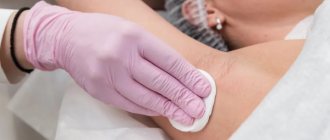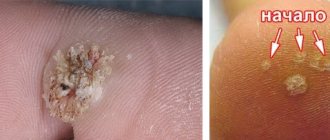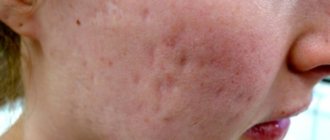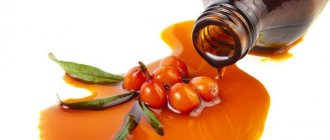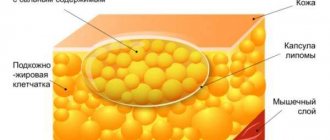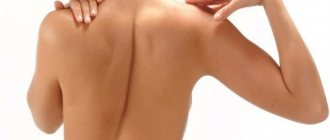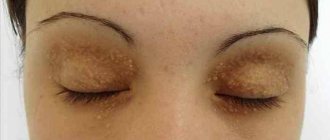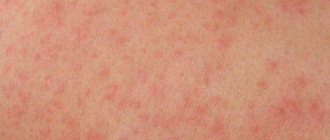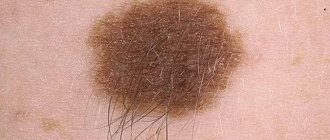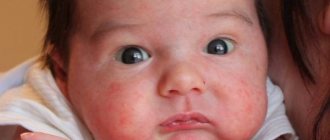What does it look like
The appearance of the rash depends on the type:
- Crystalline - consists of many small colorless bubbles located close to each other. Their size usually does not exceed 1 mm in diameter.
- Red – causes severe discomfort and can lead to serious consequences. Rashes of this type are red in color with a diameter of up to 2 mm. The vial contains a cloudy liquid, which, if opened, can cause infection.
- Papular - can trigger the development of eczema, so it should be treated immediately. Miliaria can be recognized by its appearance; many white blisters appear on the skin, the skin around which is severely inflamed. In this case, the disease is accompanied by severe itching, high fever and swelling.
In men
Most often, heat rash in men appears in the groin. The rash consists of many small bubbles no larger than 1 mm in size, located close to each other. They practically do not hurt and do not itch. However, if there is no treatment, complications and the addition of a secondary infection (suppuration, swelling and pain) are possible.
Among women
In women, prickly heat often forms in places of natural folds (in the groin, under the breasts, on the elbows, in the armpit).
The rash is a small blistering rash that is accompanied by pain and itching. In addition, it spoils the aesthetic appearance of the skin, which is especially important for women.
You should not wait for prickly heat to go away on its own. This disease can progress and lead to skin inflammation and eczema.
Why does irritation occur?
Miliaria or sweat rashes on the body in adults are not uncommon. Skin irritation is caused by the following reasons:
- high air humidity at high temperatures;
- wearing synthetic fabrics;
- skin chafing and microtraumas;
- clogged pores due to the use of low-quality cosmetics;
- diseases associated with metabolic disorders;
- obesity.
In infancy, irritation appears due to the peculiarities of thermoregulation of the newborn’s body. Most often, such skin irritation occurs in the area where the diaper fits.
In adults, prickly heat is localized in places where the skin comes into contact with clothing, as well as in natural folds. Irritation “loves” the groin area, folds under the breasts in women, the inner side of the thigh, the bends of the elbow and knee, and the armpits.
Most often, obese people experience irritation. Women observe skin irritation in the area where the edges of the bra fit, and men note irritation in the groin and perineum. Heat rash on the abdomen and in the folds between the groin and abdomen is also a problem for people who are overweight. Obese people sweat more, which means they experience heat rash more often.
Treatment of prickly heat with ointments and medications at home
Usually, treatment for prickly heat occurs at home. For this, the doctor prescribes medications and ointments aimed at relieving unpleasant symptoms and healing the skin.
If the patient is bothered by severe itching, pain and other unpleasant sensations, then antihistamines are prescribed:
- Loratodine.
- Suprastin.
- Fenkarol.
- Fenistil, etc.
To relieve inflammation, swelling, itching, as well as dry out the rash and protect the skin from infections, ointments are prescribed:
- Zinc – relieves inflammation, dries out the rash and prevents the development of infection. Desitin ointment contains zinc.
- Bepanten - relieves pain, itching and flaking, helps to heal wounds faster and promotes skin regeneration.
- Sudocrem - has properties similar to the previous ones.
If the rash does not go away for a long time, and the use of medications does not produce results, consult a doctor.
On the head
The skin on the head is often subject to irritation, including diaper rash. Without treatment, serious disruptions in the functioning of the sebaceous glands are possible.
To completely eradicate prickly heat, you need to identify the cause of its occurrence.
To relieve discomfort, you can try rinsing with a weak solution of potassium permanganate, string, chamomile and other herbs, as well as soda. Prepare the following rinse solution: 1 tbsp. chamomile, string and St. John's wort. Pour a liter of boiling water over everything. Let it sit for half an hour, strain and treat the scalp.
To relieve itching and inflammation, use the La-Cri cosmetic product. It is suitable for both adults and children. It is important to use antiseptics: potassium solution, salicylic acid. They disinfect the skin and prevent the infection from spreading.
You can also use powders that eliminate itching, reduce the amount of sweat produced and help get rid of heat rash faster. If severe itching, burning and pain bother you, then antihistamines are prescribed.
On the palm
In hot summer weather, prickly heat often appears on the hands. A predisposing factor is the wearing of gloves and overalls that do not allow the skin to breathe, the use of fatty creams, etc.
The following medications are used to treat prickly heat on the palms:
- Ointments and creams (zinc, Desitin, boric acid, etc.).
- Antihistamines (Loratodine, Fenkarol, Fexofast).
- Antibacterial agents.
- Drugs that improve metabolism.
- Vitamins and minerals.
Herbs have excellent properties: chamomile, celandine, mint, string, calendula. To prepare the solution, you need to take 1 cup of boiling water and 1 tbsp. any herbs (several are possible).
Mix all this and let it brew for 4-5 hours, then strain and lubricate your palms with it when unpleasant symptoms appear.
On the forehead and face
A doctor should treat prickly heat on the face.
If you notice prickly heat on your face, consult a doctor. Self-medication will only complicate the situation and lead to cosmetic defects.
The doctor prescribes medications that relieve itching, pain and inflammation, and also help regenerate the skin. In combination, you can use herbal decoctions. This could be oak bark, chamomile, string. Antiseptics should be used: boric acid, salicylic acid, etc.
Zinc ointment will help dry out the rash. It will relieve redness and swelling. You can take laundry soap to wash your face with in the morning and evening. It will dry out rashes and renew skin cells.
You should improve your diet, add more vitamins, minerals, vegetables and fruits.
If the face sweats a lot, decorative cosmetics should be used in minimal quantities, and preference should be given to non-greasy creams
On arms and legs
Very often, heat rash appears on the feet, and the reason for this is the daily wearing of shoes and excessive sweating.
At the initial stages of the disease, the problem can be eradicated by preventive measures. In particular, wear comfortable shoes made of natural materials, treat your feet with antiseptics (boric alcohol, potassium permanganate solution, Fukortsin).
They also use ointments and creams: Sudocrem, Calamine, Pantestin, Bepanten, etc. Medicinal herbs (chamomile, calendula), from which foot baths should be made, will also help.
If severe itching bothers you, you can try antihistamines: Fenistil, Psilo-balm, etc.
To reduce sweating, use baby powder or regular starch.
If the disease has become severe or an infection has occurred, antibiotics are prescribed: Levomekol, Baneocin, ichthyol ointment, etc.
On the back and armpits
Treatment of prickly heat should be comprehensive, that is, it is necessary to eradicate the problem itself and restore the skin. Heat rash on the back and armpits is often caused by excessive sweating and wearing synthetic clothing.
To help deal with the problem:
- Zinc ointment and other drugs that dry out the rash. To reduce sweating, you can use baby powder; it also has a drying effect.
- Bepanten, ointments with chamber and menthol. These drugs help relieve discomfort.
- Antiseptics to prevent infection on irritated skin (Fukorcin, Chlorophyllipt).
- For severe nervous tension, sedatives are prescribed.
- To relieve severe itching and swelling, antihistamines are prescribed.
To reduce sweating, Botox is used, as well as surgical methods. The second are aimed at cutting the nerve leading to the sweat gland.
In the groin
There are many reasons for prickly heat in the groin. The most common factor is constantly wearing synthetic clothing, which does not allow the skin to breathe.
An integrated approach is used to treat the disease, including the use of:
- Antiseptics that cleanse the skin and prevent the disease from progressing.
- Herbal decoctions.
- Ointments with antibacterial and drying effects.
- Antibiotics for advanced stages of the disease.
- Hormonal drugs, Botox and surgery. These methods are used when the endocrine system is disrupted.
Rules of application
When treating the skin with a powdery substance, it should be taken into account that the powder can be sprayed, and this is especially undesirable for a child. The result of the treatment will be positive if you follow the rules for applying talc to the skin:
- Before applying talcum powder, the skin should be prepared. To do this, you need to take a bath or wash problem areas with water or herbal infusions.
- The skin must be thoroughly dried by blotting it with a dry soft towel. It is important not to rub the skin so as not to increase inflammation and redness.
- Pour the powder into your palms, rub and only then apply to the skin. This will reduce the spraying of the substance in the air and reduce the contact of large amounts on the skin.
- It is necessary to apply talc only to damaged areas where there is prickly heat.
- When reapplying the powder, remove any remnants of the previous one by washing off the talc with water. Repeat the procedure from the very beginning.
Inflamed miliaria on the skin of the body: how to quickly eliminate pain and burning
To quickly relieve the pain and burning sensation of prickly heat, you can use a soda solution.
It has anti-inflammatory and antiseptic effects. To prepare, take 1 tbsp. l. warm boiled water and 1 tsp. baking soda, mix and frequently lubricate the affected area of skin.
You can also wash your face with laundry soap, which helps get rid of the rash faster. Creams such as Bepanten, Sudocrem, as well as zinc ointment, etc. are also suitable.
These drugs are aimed at quickly relieving unpleasant symptoms.
Favorite localization locations
Miliaria can be localized throughout the body: in skin folds, hairline areas, areas of skin-to-skin friction, places where clothing is tightly attached and rubbed. All parts of the body are irritated:
- head, face, neck;
- back, stomach, in women the area under the breasts;
- upper and lower limbs, between the thighs, armpits, elbow and knee areas, space between the fingers;
- groin area, glans penis, anal area.
The area where prickly heat is localized is affected by its type.
Prevention
To prevent prickly heat from recurring, preventive measures should be taken:
- Observe personal hygiene rules.
- Wear loose clothing and shoes made from natural materials.
- Avoid places with high temperatures and humidity.
- Use a minimal amount of decorative cosmetics and non-greasy creams.
- Avoid excess weight.
- Treat diseases of internal organs.
- Take enough vitamins and minerals.
If rashes appear on your body, it is better to consult a doctor. He will prescribe the necessary tests, prescribe medications that will relieve discomfort and help you get rid of the disease faster.
What is powder?
Zinc oxide ground into dust with additional substances in the form of talc and starch. The main component is zinc. It constricts blood vessels at the site of application, has a depressant effect on the site of inflammation, and reduces pain and irritation. It is a dermatological product that, when it comes into contact with the skin, has the following effects:
- adsorbent;
- drying;
- anti-inflammatory;
- regenerative.
The product is not absorbed into the blood and is safe for pregnant and lactating women, as well as small children from the first day of birth. For it to be most effective, you should choose a fine powder, similar in consistency to fatty flour. If you feel small grains on your fingers when you touch the product and your hands, this powder is not suitable, as it will clog the pores on the skin.
The powder can be used for acute purulent-inflammatory processes on the dermis and weeping wounds. It will not be effective for infected lesions and pustular diseases of the epidermis.
Air baths
This is a must in the treatment of prickly heat. Moreover: if you still doubt whether it is a heat rash or an allergy, know that air baths quickly reduce the intensity of rashes; air has no effect on an allergic rash.
The algorithm is simple:
- Ventilate the room - it should be fresh and not stuffy. Temperature – about 22-23 degrees, humidity around 65-70%, not higher;
- Undress the baby, wash, wipe dry;
- Place him on a non-safe surface - in his crib, in his playpen, on a diaper on the sofa, on his parent's bed. Just be close so that the baby doesn’t accidentally fall;
- The baby should lie on a clean diaper, under which there is a special medical diaper (oilcloth with a cotton base - in case the baby “goes to the toilet”);
- The baby can lie down like this for 10-15 minutes, later the time can be gradually increased to half an hour.
During this time, the baby’s skin will “breathe” well, and the rashes will subside. Air baths can be given 1-2 times a day, or even more often if the baby responds well to them. They significantly speed up the healing process. Just don’t use regular oilcloth as a lining; it interferes with normal air circulation.
What bathing decoctions will help?
You can buy a ready-made mixture of herbs for bathing and use it. You can make up healing fees yourself.
These recipes help fight heat rash:
- Chamomile + string. Mix pharmaceutical chamomile with a string in equal parts. Mash the raw materials and pour boiled water over the decoction in a ratio of one to two. Leave this mixture for 20 minutes. After cooling, pour the broth into the baby’s bath through gauze (to filter out debris).
- Bay decoction. Fill 15 leaves with a liter of water. Place the mixture on the fire, and after boiling, keep it on low heat for 12 minutes. After cooling, add to the bath.
- Oak bark. The bark should be poured with boiling water, per 20 g of raw material - a liter of boiled water. When the broth has cooled, pour it into the water collected for bathing.
Do not increase the dosage of medicinal herbs, this may result in an allergic reaction. There are special bathing gels with celandine, chamomile, etc. already included in the composition. There is no need to rush into switching to such cosmetics. As a rule, shampoos and gels begin to be used during water procedures when the child reaches 4 months or more. Previously, he simply did not need them: regular baby soap was enough.
Possible negative consequences
The advanced stage of miliaria in adults, papular, requires complex treatment under strict medical supervision. If timely measures are not taken, the disease leads to microbial eczema, the treatment of which can last more than a year.
On a note! The deep stage of the disease is treated with expensive procedures: iontophoresis, botulinum toxin injections. In case of particularly severe complications of miliaria, an operation is performed to intersect the nerve fibers responsible for the innervation of the sweat glands. Surgical removal of sweat glands in the affected area may be prescribed.
Causes of heat rash in children
The main reason for the appearance of heat rash in children is an insufficiently developed thermoregulation system. The baby's sweat glands have too narrow excretory ducts, so intense sweating and slow evaporation of fluid lead to their blockage and the appearance of a rash.
Babies' skin is much thinner than adults'. In delicate places (butt, elbows, neck, back, etc.) the pH level of children's skin is neutral, and normal thermoregulation requires an acidic environment. Plus, human sweat contains salts and other substances that have an irritating effect on the skin, and if their excess is not eliminated in a timely manner, leading to the growth of microbes and rashes.
Also, prickly heat in a child occurs due to insufficient hygiene. On dirty skin, pathogenic flora multiplies faster, which leads to disruption of excretory function. During extreme heat, prickly heat in children is most often localized on the neck, shoulders, back of the head, elbow bends, i.e. in areas of the body inaccessible for ventilation. In this case, the skin simply cannot cope with such intense sweating.
The cause of prickly heat can be excessive wrapping in warm clothes in hot weather. A greenhouse effect occurs, and as a result, the body becomes covered in a rash. The formation of a rash is also promoted by the use of fatty creams, which create a film on the skin, disrupting its respiratory function.
Children sweat a lot with infectious or viral diseases during a strong rise in temperature. If caring parents also wrap them up in this state, prickly heat will not be long in coming.
